Understanding how, when and why suspension lines break is key to avoiding accidents. If you don’t know the hazards, it is easy to make mistakes and this is one area where you cannot afford them as they could result in serious injury or even death. As they say, there are no accidents, only pilot error. So, pay close attention. What follows is the result of observation, reading too many incident reports and experiments to test some of the theories.
I have added the results of my experiments as a free preview of Suspension techniques: Part I’, the first part of our 12-part suspension course.
The main points
The most significant take-aways from all this are:
Not all rope is equal:
Natural fibre rope varies in quality, even within the same brand, and thus in strength. Jute and hemp are like any other plant, they vary according to strain, soil, weather, geography . The yarn will differ in the way is constructed and manufactured, so will the resulting rope. Typically, you can’t even rely on comparing diameter as it is hard to measure accurately and, anyway, most sizes are nominal with the true size being 5-10% greater. As the tests show, tensile strength is irrelevant, the factor that determines the cause of failure is likely to be friction. It will almost invariably be friction and/or a shock loading that precipitates the chain of events. Don’t under-specify critical lines.
The bight failure myth:
Despite what you might think, it is rarely the bight that fails. Conversely, it is abrasion by the bight that causes the running line (lift line) to become damaged.. For critical lines, use a double-bight or, better, a carabiner. A double-bight is gives a fail-safe against it breaking but a carabiner reduces the risk of friction damage leading to failure of the running line.
Friction is your enemy:
Whilst friction can aid control, avoid creating it unnecessarily. Friction, as the experiments show, strips yarns leading to a domino effect causing premature failure at well below the rope’s tensile capability. Use the ‘winding a grand-father clock’ technique where you pull down on the line with one hand and up with the other where possible to reduce load on the bight.. Keep you rope in perfect condition and sufficiently lubricated. Consider how you can reduce friction on moving lines with wider diameter hardware, e.g. rings, carabiners.
Don’t use 5mm for critical lines:
By all means tie with 5mm but always use something stronger for critical lines, i.e. those supporting the main load. If a break would cause a major issue, don’t risk it. Use common sense and risk assess. If you are inverting, it presents one of the highest risks, be very generous with your margins. On the other hand, failure of a non-critical line like one supporting a leg line in a sideways or face-down suspension presents negligible risk so I would have no concern over using 5mm.

